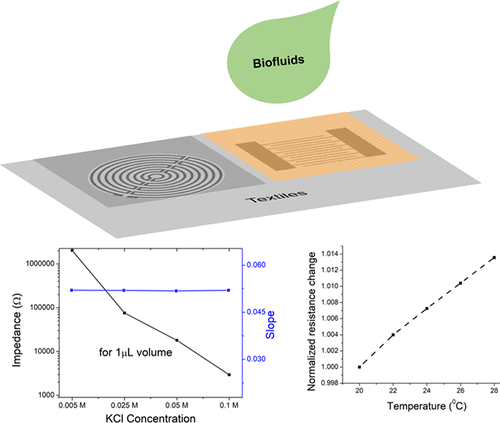Our official English website, www.x-mol.net, welcomes your feedback! (Note: you will need to create a separate account there.)
Monitoring Body Fluids in Textiles: Combining Impedance and Thermal Principles in a Printed, Wearable, and Washable Sensor
ACS Sensors ( IF 8.9 ) Pub Date : 2021-01-27 , DOI: 10.1021/acssensors.0c02037 Manoj Jose 1, 2 , Gilles Oudebrouckx 1, 2 , Seppe Bormans 1, 2 , Paula Veske 3 , Ronald Thoelen 1, 2 , Wim Deferme 1, 2
ACS Sensors ( IF 8.9 ) Pub Date : 2021-01-27 , DOI: 10.1021/acssensors.0c02037 Manoj Jose 1, 2 , Gilles Oudebrouckx 1, 2 , Seppe Bormans 1, 2 , Paula Veske 3 , Ronald Thoelen 1, 2 , Wim Deferme 1, 2
Affiliation

|
This work explores the feasibility of coupling two different techniques, the impedance and the transient plane source (TPS) principle, to quantify the moisture content and its compositional parameters simultaneously. The sensor is realized directly on textiles with the use of printing and coating technology. Impedance measurements use the fluid’s electrical properties, while the TPS measurements are based on the thermal effusivity of the liquid. Impedance and TPS measurements show equal competency in measuring the fluid volume with a lowest measurable quantity of 0.5 μL, enabling ultralow volume passive measurements for sweat analysis. Both sensor principles were tested by monitoring the drying of a wet cloth and the measurements show perfect repeatability and accuracy. Nevertheless, when the biofluid property changes, the TPS sensor does not reflect this information on its readings, whereas, on the other hand, impedance can provide information on compositional changes. However, since the volume of the fluid changes simultaneously, one cannot differentiate between a volume change and a compositional change from impedance measurements alone. Therefore, we show in this work that we can apply impedance to measure the compositional properties; meanwhile, the TPS measurements accurately carry out volume measurements irrespective of the interferences from its compositional variations. To prove this, both of these techniques are applied for the quantification and composition monitoring of sweat, showing the capability to measure moisture content and compositional parameters simultaneously. TPS measurements can also be an indicator of the local temperature of the medium confined by the sensor, and it does not influence the fluid parameters. Compiling both impedance and thermal sensors in a single platform triggers smart wearable prospects of metering the liquid volume and simultaneously analyzing other compositional changes and body temperature. Finally, the repeatability and stability of the sensor readings and the washability of the device are tested. This device could be a potential sensing tool in real-life applications, such as wound monitoring and sweat analysis, and could be a promising addition toward future smart wearable sensors.
中文翻译:

监测纺织品中的体液:在印刷,可穿戴和可清洗传感器中结合阻抗和热原理
这项工作探讨了结合阻抗和瞬态平面源(TPS)原理这两种不同技术来同时量化水分含量及其组成参数的可行性。通过使用印刷和涂层技术,该传感器可直接在纺织品上实现。阻抗测量使用流体的电特性,而TPS测量则基于液体的热发射率。阻抗和TPS测量显示出在最小量为0.5μL的流体体积测量方面的能力,可进行汗液分析的超低体积被动测量。两种传感器原理均通过监测湿布的干燥进行了测试,并且测量结果显示出完美的可重复性和准确性。但是,当生物流体特性发生变化时,TPS传感器不会在其读数上反映此信息,而另一方面,阻抗可以提供有关成分变化的信息。但是,由于流体的体积同时变化,因此不能仅通过阻抗测量来区分体积变化和成分变化。因此,我们在这项工作中表明,我们可以应用阻抗来测量成分特性。同时,TPS测量准确地执行体积测量,而不受其成分变化的干扰。为了证明这一点,这两种技术均用于汗液的定量和成分监测,显示了同时测量水分含量和成分参数的能力。TPS测量值也可以指示传感器所限制的介质的局部温度,并且不影响流体参数。在单个平台上同时编译阻抗传感器和热传感器,将触发可穿戴智能的前景,即可以测量液体体积并同时分析其他成分变化和体温。最后,测试传感器读数的可重复性和稳定性以及设备的可清洗性。该设备可能是现实应用中的潜在传感工具,例如伤口监测和汗液分析,并且可能是未来智能穿戴式传感器的有希望的补充。在单个平台上同时编译阻抗传感器和热传感器可触发智能可穿戴的前景,该前景可用于计量液体量并同时分析其他成分变化和体温。最后,测试传感器读数的可重复性和稳定性以及设备的可清洗性。该设备可能是现实应用中的潜在传感工具,例如伤口监测和汗液分析,并且可能是未来智能穿戴式传感器的有希望的补充。在单个平台上同时编译阻抗传感器和热传感器,将触发可穿戴智能的前景,即可以测量液体体积并同时分析其他成分变化和体温。最后,测试传感器读数的可重复性和稳定性以及设备的可清洗性。该设备可能是现实应用中的潜在传感工具,例如伤口监测和汗液分析,并且可能是未来智能穿戴式传感器的有希望的补充。
更新日期:2021-03-26
中文翻译:

监测纺织品中的体液:在印刷,可穿戴和可清洗传感器中结合阻抗和热原理
这项工作探讨了结合阻抗和瞬态平面源(TPS)原理这两种不同技术来同时量化水分含量及其组成参数的可行性。通过使用印刷和涂层技术,该传感器可直接在纺织品上实现。阻抗测量使用流体的电特性,而TPS测量则基于液体的热发射率。阻抗和TPS测量显示出在最小量为0.5μL的流体体积测量方面的能力,可进行汗液分析的超低体积被动测量。两种传感器原理均通过监测湿布的干燥进行了测试,并且测量结果显示出完美的可重复性和准确性。但是,当生物流体特性发生变化时,TPS传感器不会在其读数上反映此信息,而另一方面,阻抗可以提供有关成分变化的信息。但是,由于流体的体积同时变化,因此不能仅通过阻抗测量来区分体积变化和成分变化。因此,我们在这项工作中表明,我们可以应用阻抗来测量成分特性。同时,TPS测量准确地执行体积测量,而不受其成分变化的干扰。为了证明这一点,这两种技术均用于汗液的定量和成分监测,显示了同时测量水分含量和成分参数的能力。TPS测量值也可以指示传感器所限制的介质的局部温度,并且不影响流体参数。在单个平台上同时编译阻抗传感器和热传感器,将触发可穿戴智能的前景,即可以测量液体体积并同时分析其他成分变化和体温。最后,测试传感器读数的可重复性和稳定性以及设备的可清洗性。该设备可能是现实应用中的潜在传感工具,例如伤口监测和汗液分析,并且可能是未来智能穿戴式传感器的有希望的补充。在单个平台上同时编译阻抗传感器和热传感器可触发智能可穿戴的前景,该前景可用于计量液体量并同时分析其他成分变化和体温。最后,测试传感器读数的可重复性和稳定性以及设备的可清洗性。该设备可能是现实应用中的潜在传感工具,例如伤口监测和汗液分析,并且可能是未来智能穿戴式传感器的有希望的补充。在单个平台上同时编译阻抗传感器和热传感器,将触发可穿戴智能的前景,即可以测量液体体积并同时分析其他成分变化和体温。最后,测试传感器读数的可重复性和稳定性以及设备的可清洗性。该设备可能是现实应用中的潜在传感工具,例如伤口监测和汗液分析,并且可能是未来智能穿戴式传感器的有希望的补充。



























 京公网安备 11010802027423号
京公网安备 11010802027423号